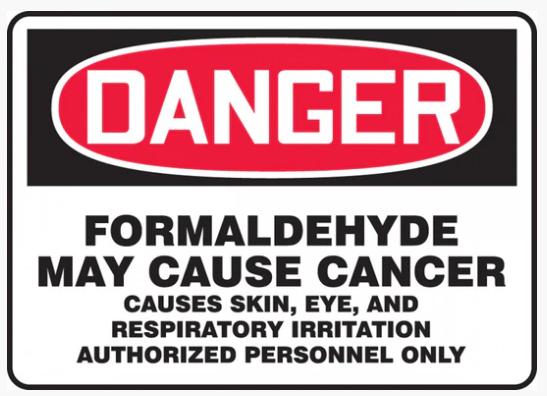Volatile organic compounds (VOCs) include a wide range of chemicals used in many products and materials today. These VOCs are emitted as gases from certain solids or liquids and many are known to have potential adverse health effects for anyone exposed to long-term or elevated levels of these compounds.

Concentrations of many VOCs are consistently higher indoors than outdoors since they are emitted from so many products found in modern homes and buildings. Examples of common sources include: paints, paint strippers, and other solvents; wood preservatives; aerosol sprays; cleaning supplies, disinfectants and pesticides; air fresheners; stored fuels and automotive products; hobby supplies; dry-cleaned clothing; building materials and furnishings; glues and adhesives.
We use a depressurized 1 hour cannister to take a core air sample and send to the lab for analysis.

Formaldehyde is a commonly used chemical compound that exists in various forms and at room temperature, is a colorless, distinctive, strong and even pungent smelling, flammable and gaseous substance. Formaldehyde has been used in a number of industries for various purposes such as: for the manufacturing of building materials – like pressed wood products (mostly as an adhesive resin), fiber board, plywood, cigarette smoke, fuel burning appliances and kerosene space heaters. Additional uses in household products include: additive for permanent –press, an ingredient in glues, and as a preservative in medical laboratories – as embalming fluid, and as a sterilizer. Since Formaldehyde is a by-product of combustion and other inherent processes, it can be found in significant concentrations and in various environments.
We use badge testing for air samples and 2×2 wipes for surface testing.
It is also critical to note that the ’11th Report on Carcinogens” classifies formaldehyde as “reasonably anticipated to be a human carcinogen”.
The following is a list of products that might have used formaldehyde in their production – meaning that industries that produce these products could benefit from a regular monitoring program. This list is not meant to be all inclusive and it is important to note that while formaldehyde may have been used in the production, it may not be present on the final products
Manufactured products: Paper towels, photographic film, shampoo, deodorant, toothpaste, lipstick and nail polish, some glues use formaldehyde as a bonding agent, formaldehyde-based resins are used to manufacture composite panel products, automobiles make use of formaldehyde for various units, various forms of inks, wrinkle free fabrics, building materials (as mentioned above).
Why continue to use formaldehyde? Formaldehyde has exceptional properties that cannot be easily replaced by other products; therefore, it is necessary to continue its use until there are additional alternatives available on the commercial market.
Potential Health Related Issues: As mentioned on previous pages, formaldehyde can be found in many products that are all around us. Much of the formaldehyde that people are exposed to comes from its use in the production of polymers that are found in many products used to build and furnish our homes and offices. The chemical is commonly used in countless manufacturing processes and as a key ingredient in many building supplies and furnishings. The list of formaldehyde containing substances is extensive and can involve a number of common products.
In recent years, the health effects associated with elevated levels of exposure have brought to light the dangers from prolonged and repeated contact with chemical. The major exposure risks associated with formaldehyde come from occupants inhaling contaminated air.
Exposure to elevated levels of this substance should be avoided whenever possible as exposures to high levels of formaldehyde can trigger:
• asthma attacks
• nausea
• watery and/or burning eyes
• difficulty breathing
• headaches
• respiratory irritation
• sensitization
Caution: Formaldehyde has been shown to cause cancer in animals and according to the Department of Health and Human Services (DHHS), formaldehyde may “reasonably be anticipated to be a carcinogen”.